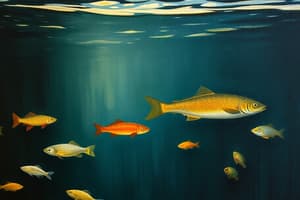Podcast
Questions and Answers
What is the fundamental concept that illustrates how energy flows from one organism to another in ecosystems?
What is the fundamental concept that illustrates how energy flows from one organism to another in ecosystems?
- Abiotic components
- Species composition
- Food chain (correct)
- Physical conditions
Which organisms make their own food via photosynthesis in the food chain?
Which organisms make their own food via photosynthesis in the food chain?
- Consumers
- Fungi
- Plants (correct)
- Bacteria
In the food chain, consumers feed off which category of organisms?
In the food chain, consumers feed off which category of organisms?
- Primary producers (correct)
- Topography
- Secondary consumers
- Abiotic components
What does each link along the food chain represent?
What does each link along the food chain represent?
Which component can be considered part of an ecosystem's niche according to the text?
Which component can be considered part of an ecosystem's niche according to the text?
What is the role of owls in the grassland food chain?
What is the role of owls in the grassland food chain?
In a forest food chain, what is the role of herbivorous insects?
In a forest food chain, what is the role of herbivorous insects?
What do scavengers in the deep sea food chain primarily feed on?
What do scavengers in the deep sea food chain primarily feed on?
What is the significance of maintaining ecological diversity?
What is the significance of maintaining ecological diversity?
What is the main function of producers in a food chain?
What is the main function of producers in a food chain?
Flashcards are hidden until you start studying
Study Notes
Ecosystems: Unraveling Nature's Complex Weave through Food Chains
Ecosystems serve as nature's living laboratories – intricate webs where life thrives within a delicate balance of interdependent relationships. At the heart of this web lies the food chain, a fundamental concept illuminating how energy flows from one organism to another. In this exploration, we dive into ecosystem basics with special emphasis on understanding our natural world through these indispensable chains of energy transfer and consumption.
Introduction to Ecosystems
An ecosystem is defined by biologists as a community of living organisms interacting with each other and their environment. This encompasses the relationship between plants, animals, fungi, bacteria, abiotic components like water, air, soil, and sunlight, and the interactions among all involved. Every ecosystem can be thought of as its own unique niche, set apart by geographical location, physical conditions like climate and topography, and species composition.
Importance of Food Chains
Food chains illustrate the linear progression of energy flow within ecosystems, moving from producers who make their own food via photosynthesis, such as plants, algae, and some types of bacteria, up to consumers, which feed off those primary producers and eventually become prey themselves in the next higher trophic level. Each link along this chain represents a specific type of interaction.
For instance, let’s consider the following simple grassland food chain:
Grass → Grasshopper → Bird → Owl
In this scenario, grass is the base or producer, the grasshopper feeds on it, making grasshoppers herbivores or primary consumers. Then birds eat the grasshoppers, becoming secondary consumers and predators, while owls sit atop the food chain preying upon the songbirds, forming part of the tertiary consumer group.
Real-World Examples of Food Chains
One famous example of a complex food chain occurs at the ocean floor known as the deep sea. These environments often feature diverse food chains based around scavengers eating detritus – dead organic material – or consuming smaller creatures such as plankton, worms, and shrimp. For example, certain fish will consume larger crustaceans, seals may hunt them, and orcas have been observed feeding on seals in turn, creating a multi-tiered marine food chain.
Similarly, forest food chains demonstrate the interconnectedness of various habitats and niches. Decomposers like microorganisms break down fallen leaves and decaying trees, providing nutrients for tree roots and releasing carbon back into the atmosphere through respiration. Herbivorous insects graze on plant materials, contributing to the cyclical process of nutrient release. As you move further up the chain, predators such as carnivorous mammals, reptiles, and birds, target both primary and secondary consumers, completing the cycle.
Conclusion
Understanding food chains provides valuable insight into the structure and function of ecosystems, emphasizing the importance balancing predator and prey populations and highlighting the significance of maintaining ecological diversity. By exploring these basic concepts, we gain a deeper appreciation for the complexity of living systems and reinforce our commitment to protecting and conserving our planet's vastly varying habitats and ecosystems.
Studying That Suits You
Use AI to generate personalized quizzes and flashcards to suit your learning preferences.



